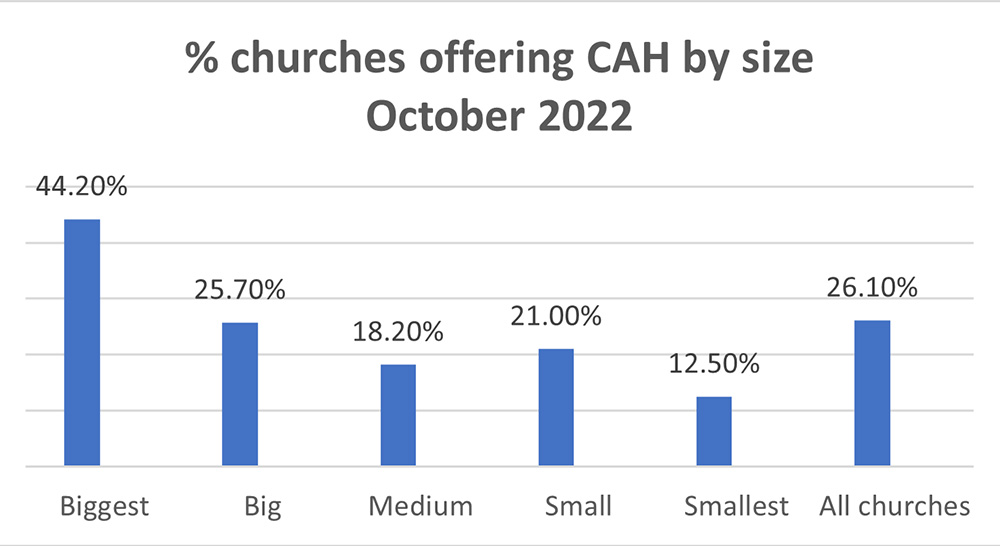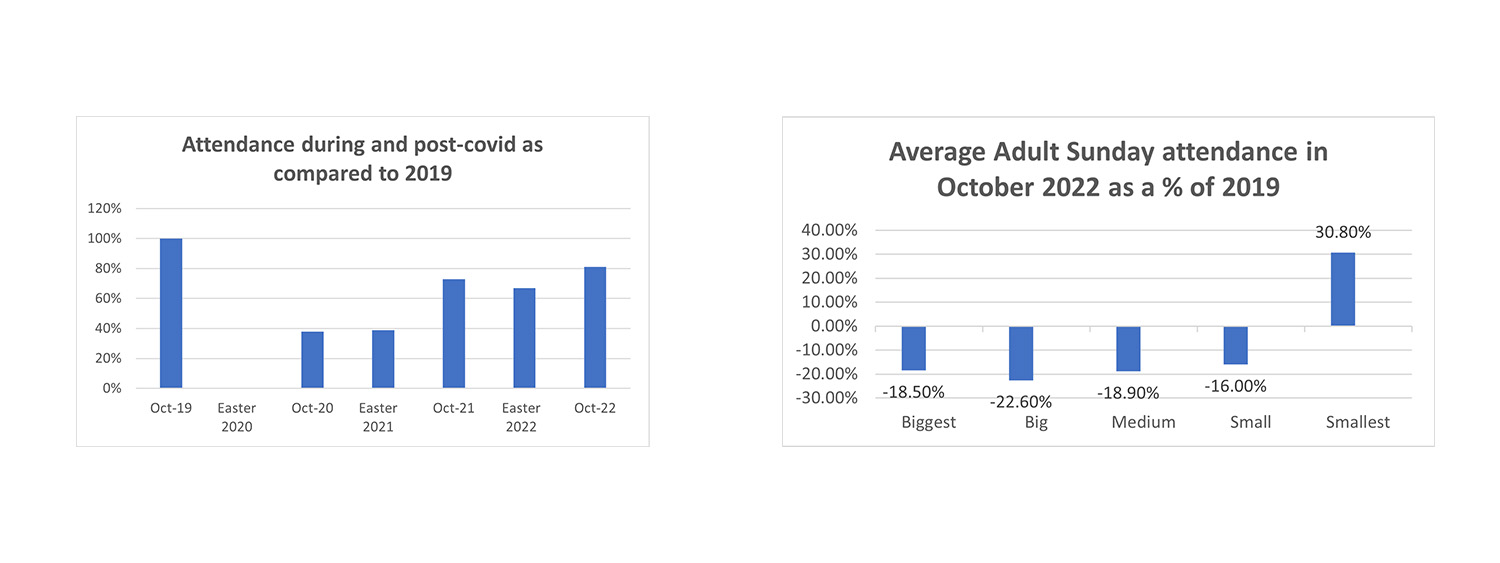
In early 2022, it appeared that Easter 2022 would mark both the end of Covid restrictions and of Covid-induced reluctance to attend church services. In the event, a late resurgence of a Covid sub-variant meant that England was not free of Covid at Easter 2022. So, together with four other dioceses, we compared October 2022 attendance figures with the last ‘normal’ year of 2019 to see what could be learned from changes in church attendance over this period. Our thanks to the many churches who responded to the request to submit attendance figures to the Parish Return System earlier than usual.
We grouped churches into five equal groups by increasing average weekly attendance (AWA) in 2019 (Smallest, Small, Medium, Big and Biggest). The data shows that, overall, on-site church attendance recovery from Covid lockdown seems to have slowed down and by October 2022 was at 81% of the 2019 level.
What did we find out?
- Recovery was slightly stronger in smaller churches than larger ones. The smallest churches are the only size group to have recovered back to their 2019 attendance level, and even that group is boosted by one church with an exceptional increase.
-
Recovery was strongest among adults attending standard church services on a Sunday. As these are also the services most likely to be livestreamed, the overall difference is even more marked than these figures would suggest.
-
Adult attendance has recovered less strongly on weekdays and in fresh expressions of church, but the numbers attending these services are far fewer than adults attending traditional Sunday services. This means that overall adult attendance in October 2022 was 82% of the level of 2019.
-
Child attendance in 2022 was 77% of 2019, so a lower recovery than for adults. Child attendance at standard services was 79% but at fresh expressions of church was only 58%. There is clearly a bigger rebuilding job among children than among adults.
-
The average attendance drop was greater on weekdays than on Sundays. Sunday congregations in October 2022 comprised 83% of the people of 2019 but weekday congregations only 71%. The biggest losses were in services containing children.
-
The fresh expressions (FxC) movement has also seen a lower recovery rate. All-age weekly attendance at standard church services in 2022 was 82% of 2019, at fresh expressions of church it was 71%. Child attendance fell more than adult attendance – the number of children at FxCs in 2022 was 58% of 2019, while adults were 90% of 2019. This suggests that the most hard hit were family-friendly fresh expressions, such as Messy Church.
-
In October 2022 churches offered 82% of the number of services they had in 2019. There were 15% fewer Sunday services, and 22% fewer weekday services.
-
Churches that have not reduced their services have on average recovered their 2019 congregations. But many churches have reduced the number of their services since 2019, and 29% now do not have at least one service every week. These churches have a greater gap between their 2022 and 2019 average attendance levels.
-
Those churches that had one or more fewer services each month saw on average 26 fewer people in their congregation. Those with the same number of services in October 2019 and 2022 saw on average four fewer people in their congregation, and the churches that held one or more extra services each month saw on average four additional people in their congregation.
-
For all but the smallest churches the number of people attending each service was very similar to that in 2019: the difference is seen in the number of services. So, it is not that fewer people are going to each service, but that similar numbers of people are going to the services, there are just fewer services.
How has Church at Home affected attendance?
-
 Church attendance changed considerably between 2019 and 2022 with the introduction of Church at Home (aka online church services) arrangements when our churches were closed because of the restrictions of the Covid era.
Church attendance changed considerably between 2019 and 2022 with the introduction of Church at Home (aka online church services) arrangements when our churches were closed because of the restrictions of the Covid era. -
The estimated percentage of churches offering Church at Home has fallen from 59% in October 2021 to 26% in October 2022, halving in the year to October 2022. Almost all the Church at Home offerings in October 2022 were online, and most of those were YouTube.
-
It seems that Church at Home is mainly not acting as a substitute for on-site attendance; it is in addition to it. Churches should not expect that stopping their online services will cause a balancing increase in on-site attendance.
-
Larger churches were more likely to be offering Church at Home (44%). The larger the church the more likely it was to offer services online, so the proportion of congregation members in the diocese with access to their own church’s Church at Home offering (36%) is higher than the proportion of churches offering Church at Home.
-
We estimate that in October 2022 online attendance added 15% to total on-site all-age weekly attendance in October 2022 and 35% to the attendance of those churches with an online presence.
-
Including the Church at Home estimates for October 2022 increased our estimate of total AWA (average weekly attendance) from 81% to 93% of 2019 AWA.
How might my church respond?
"As God’s life flows back into the vine from this long winter, we need to be putting creativity and resources into re-opening when we can those midweek and Sunday services and beginning new congregations – especially those focussed on children, young people and families. Where that happens – and we see it happening – there are signs of hope and life"
- Bishop Steven
- Read and share Bishop's Steven's commentary on these findings with your PCC and wider congregation.
-
Revisit your October 2019 and 2022 figures of attendance and number of services and assess whether the findings summarised here are reflected in your services week by week.
-
Do you know who is missing now from your 2019 congregation? Now is a good time to hold a ‘back to church invitation Sunday’, especially inviting those who have not yet returned. Check out the Love Your Church story from Bernwode benefice for a great example of a simple change that made a huge difference for them.
-
Our findings suggest that numbers grow when appropriate provision is made and shrink when it is withdrawn. This is true in relation to the number of weeks a month that churches are open, to the number of services offered, to the availability of child-friendly services and fresh expressions. Recovering fresh expressions along with services for children and families can replace those not restarted after Covid. If you haven't done so already, check out our Disciples Together resources and discover how to put children, young people and families at the centre of a more Christ-like Church.
-
If you do not provide Church at Home, consider offering livestreaming of your service (although it may not be the right choice for every church). The Development Fund is open to applications for funding to set up livestreaming, and the diocese has produced a simple how-to guide for churches new to streaming.
-
As you think about planning for the future Emerging from Coronavirus is a useful resource based on the Anglican Five Marks of Mission. It invites parish leadership teams to reflect on ‘what has been lost through the pandemic which we need to grieve, what has been reduced that we need to let go of or to build up again, and what has emerged that we need to respond to?’
-
For parishes/benefices looking to go deeper, the Parish Planning Tool is designed to help PCCs and local leadership teams explore God’s call for your church and to move forward in new and transformed ways.
-
Contact one of our Parish Development Advisors (PDAs) for advice and support. Find PDA contact details and further information on discerning God's call for your church.
